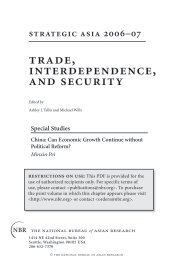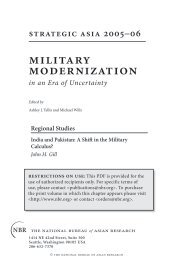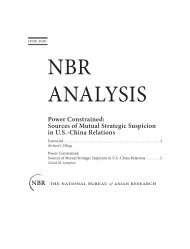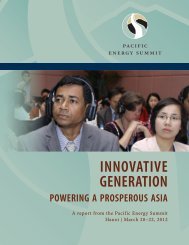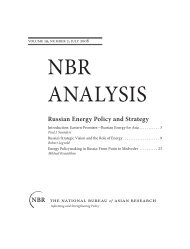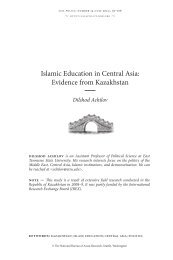Download - The National Bureau of Asian Research
Download - The National Bureau of Asian Research
Download - The National Bureau of Asian Research
- No tags were found...
Create successful ePaper yourself
Turn your PDF publications into a flip-book with our unique Google optimized e-Paper software.
2012 Summit PapersA Case Study on Power Sector Restructuring in VietnamNguyen Anh Tuan All 2012 Summit Papers are available for download from www.nbr.org. NGUYEN ANH TUAN is Director <strong>of</strong> the International Relations Department at the Institute <strong>of</strong> Energy inHanoi, Vietnam. He can be reached at .
Pacific Energy Summit • 2012 Summit Papers • NguyenEXECUTIVE SUMMARYThis essay provides a case study on power sector restructuring in Vietnam.Main ArgumentOver the last decade, the rapid growth and expansion <strong>of</strong> Vietnam’s economy has dramaticallyincreased the demand for electricity in the country. Faced with this challenge, Vietnam’s powerindustry has struggled to expand and improve the country’s power system, as evidenced bydifficulties with developing new resources, enhancing high-voltage transmission lines, andreducing transmission and distribution losses. However, in 2006, the government approved aroadmap for establishing a competitive power market and began to restructure the electricitysector, starting with establishing Vietnam Electricity (EVN) as a private holding company. Thisessay provides an overview <strong>of</strong> the key features <strong>of</strong> the restructuring and reform process <strong>of</strong>Vietnam’s power sector and then assesses both its success to date and the road ahead forcontinued progress. It argues that as a result <strong>of</strong> unbundling, competition in the electricity sector isincreasing and the quality <strong>of</strong> power networks has improved.Policy ImplicationsVietnam has embarked on an ambitious long-term program to completely restructure itspower sector, which may span twenty years from beginning to end. However, criticalstrategic choices will need to be made over the next few years to adhere to this program.<strong>The</strong>re are still many framework limitations to establishing a perfect power market inVietnam. Government authorities should review their experiences with EVN to developand prioritize optimal strategies for further unbundling. This process should also take intoconsideration the need to develop new shareholder companies that are financially viableand have the desire to ensure a solid foundation for future expansions <strong>of</strong> thepower market.Creating an effective power market cannot be done through unbundling alone andrequires holistic approaches to the energy sector. Among other tasks, this will requirereforming electricity tariffs, allowing utilities to have decent operational margins, andimproving and developing infrastructure to deliver electricity to customers.1
Pacific Energy Summit • 2012 Summit Papers • Nguyen<strong>The</strong> Power System in Vietnam: An AssessmentMain Features <strong>of</strong> the Power Sector in VietnamElectricity demand and supply in Vietnam. With the rapid growth and expansion <strong>of</strong>the Vietnamese economy over the last decade, power demand has been increasingdramatically. With an average annual growth <strong>of</strong> power demand <strong>of</strong> 14.5% from 2001 to2010, electricity demand reached 86.5 terawatt-hours (TWh) in 2010, three and a halftimes as great as demand in 2001.Figure 1: Power generation and growth rate in Vietnam during 2000–2010.120000100000Electricity Điện sản generation xuất-GWh – Growth tăng trưởng-%rate %16.9%10007118%17%8694816%80000600004000015.2%13.9%31137759556869914.7%536476053313.5%4127513.4% 13.4%4679012.8%14.5%15.1%15%14%13%20000270403641012%11%10.6%02000 2001 2002 2003 2004 2005 2006 2007 2008 2009 201010%Source: “Power Development Plan VII,” Institute <strong>of</strong> Energy, 2011.In order to meet this rapidly growing demand, Vietnam’s power industry hasstruggled to expand and improve the power system by developing its resources,enhancing transmission lines that connect the country’s three regions (north, center, andsouth), and reducing transmission and distribution (T&D) losses. Power resourcedevelopment was facilitated not only by investment from Vietnam Electricity (EVN), but2
Pacific Energy Summit • 2012 Summit Papers • Nguyenalso by Build-Operate-Transfer (BOT) schemes granting concessions for constructionand development, and independent power producer (IPP) schemes through theparticipation <strong>of</strong> private capital. As a result, the firms PetroVietnam (PVN) and Vietnam<strong>National</strong> Coal and Mineral Industries Group (Vinacomin) now represent 14.4% <strong>of</strong> totalinstalled capacity, and other IPP/BOT schemas (not including PVN and Vinacomin)represent 25.3% <strong>of</strong> total installed capacity. EVN has also completed a parallel, secondnorth-south 500 kilovolt (kV) line totaling 3,232 kilometers (km) as <strong>of</strong> 2005, andstrengthened power transfer capabilities among the regions. T&D losses fell sharply,from 21.40% in 1995 to 11.00% in 2006 and 10.15% in 2010, largely due toimprovements in management.Figure 2: Installed capacity mix by owners in 2010Installed capacity mix by ownersPVN9.5%Foreigners9.9%ImportOthers4.7% 0.8%Vinacomin4.9%JS12.5%Privates2.3%EVN55.3%Source: Institute <strong>of</strong> Energy, 2011.<strong>The</strong> power sector structure. As <strong>of</strong> January 2012, the key organizations inVietnam’s power sector are DGE (Directorate General <strong>of</strong> Energy, under the Ministry <strong>of</strong>Industry and Trade, or MOIT), 1 ERAV (Electricity Regulatory Authority <strong>of</strong> Vietnam),1 DGE was established in October 2011, replacing the Department <strong>of</strong> Energy within MOIT.3
Pacific Energy Summit • 2012 Summit Papers • Nguyenand EVN. DGE is responsible for overall energy planning and policy, but not for day-todaymanagement. ERAV is the country’s regulatory agency, responsible for establishingand supervising the power market, power planning, tariff regulation, and licensing. EVNis a state-owned and monopolistic utility that is responsible for the whole chain <strong>of</strong>electricity production, transportation, and distribution.Figure 3: Government institutions in the power sectorGovernmentMOITERAVEVN/Electric PowerTrading co.,Government• Asset owner• Approve the electricity tariff• Promulgate legal framework• Approve PDP, Energy DP, nuclear facilityMOIT• Approve Local/regional DP, Hydro PDP• Submit PDP, Energy DP to GovernmentGeneral Directorate <strong>of</strong> Energy• Submit and appraise PDP, Energy DP,Local/regional DP, Hydro PDP to MOITManagement <strong>of</strong> such approved DPGeneral Directorate• Management <strong>of</strong> Power BOT projects• Submit the plan/location/policy/manpower<strong>of</strong> Energyon nuclear power facilities to MOIT andGovernmentERAV• Licensing• Regulatory body in competitive powerContractOutside EVNmarket• Electricity tariff and rates regulatingBOT, IPP, JVon Power Generation or distributionSource: Elaborated by this study.<strong>The</strong> restructuring process <strong>of</strong> 2003–10. In the past, Vietnam’s power sector wasdominated by EVN, but its position has since been challenged by other state-ownedenterprises (SOE) and IPPs as well as BOTs since 2005 when the electricity law thatoutlines the principles <strong>of</strong> the Vietnamese government’s policy for the power sector cameinto effect. <strong>The</strong> law’s key objective is to develop a power market based on the principles<strong>of</strong> transparency and competition that achieves economic efficiency and attracts publicand private investments. <strong>The</strong> law also states that the state monopoly in the sector wouldbe limited to power transmission, national load dispatch, and strategically important largepower plants, leaving power distribution and non-strategic power generation to potentialprivate investors.4
Pacific Energy Summit • 2012 Summit Papers • NguyenRestructuring <strong>of</strong> the electricity sector was initiated with the establishment <strong>of</strong> EVNas a holding company in 2006. In June 2006, EVN was converted into a holding companystructure with a number <strong>of</strong> strategic business units; the units engaged in powerdistribution were established as independent accounting units (pr<strong>of</strong>it centers), whiletransmission and generation units were viewed as non-revenue dependent accountingunits (cost centers). In April 2007, the government approved an equitization plan 2 for thepartial privatization <strong>of</strong> most <strong>of</strong> the operating units engaged in power generation anddistribution, with EVN keeping more than 50% <strong>of</strong> share capital. However, equitizationwas no longer pursued when the global financial crisis made it increasingly difficult t<strong>of</strong>ind investors.In 2006 the Vietnamese government approved a roadmap for establishing acompetitive power market that envisages a phased approach to reforms. <strong>The</strong> first phasecomprises the establishment <strong>of</strong> a competitive generation market; it was expected to startin late 2009 or early 2010 but was delayed (see next paragraph). A single buyer wouldbuy electricity from the generating companies and sell it to distribution companies andlarge consumers at regulated prices. <strong>The</strong> next phase will entail a wholesale competitivemarket where sellers (power plants) and buyers (distributors and large consumers) willcompetitively transact in a power pool. This phase is scheduled to start in 2014 with apilot wholesale market. <strong>The</strong> final stage, scheduled to start in 2022, will be a competitiveretail market, where retail consumers will be allowed to choose their supplier.As <strong>of</strong> July 2011, MOIT decided to begin implementing the pilot competitivemarket. In the pilot phase, 48 <strong>of</strong> the 73 power plants with installed capacity greater than30 megawatts (MW) will directly bid in the market. <strong>The</strong> total installed capacity <strong>of</strong> theplayers in the market account for approximately 61% <strong>of</strong> the total installed capacity <strong>of</strong> thepower system. BOT plants (e.g., Phu My 3 and Phu My 2.2) will be bid in the market bythe representative <strong>of</strong> the power purchase company to ensure responsibility for payment.Big hydroelectric plants that have multi-strategic objectives (e.g., Son La, Hoa Binh, andIaly) will not participate in the market and continue to operate as usual to ensure optimal2 Equitization in Vietnam is a process <strong>of</strong> transforming a state-owned enterprises into a joint-stock company,and it is considered partial privatization.5
Pacific Energy Summit • 2012 Summit Papers • Nguyencoordination between power generation and social goals (i.e., managing flood control andirrigation).Power sources. By the end <strong>of</strong> 2010, total installed capacity <strong>of</strong> the system was21,542 MW, including 20,542 MW from domestic power plants and 1,000 MW importedfrom China. <strong>The</strong> available capacity was 19,735 MW, <strong>of</strong> which EVN power plantscontributed 13,466 MW (68%) and non-EVN power plants contributed 6,269 MW (32%).Presently, large hydropower contributes 37% to total capacity; gas turbines contribute14.9%; coal-fired plants make up 11.5%; and IPPs, BOT projects, and imports have ashare <strong>of</strong> 32%. Oil-fired plants, diesel plants, and small hydropower plants make up therest. 3 Table 1: Total installed capacities during 2004–10Year 2004 2005 2006 2007 2008 2009 2010Total installed capacities <strong>of</strong>power system (MW)Increase from the previous year(MW)11,469 11,578 12,270 13,512 15,763 18,481 21,5421,459 109 1,192 1,242 2,251 2,718 5,779Source: “Power Development Plan VII,” Institute <strong>of</strong> Energy, 2011.3 EVN Operations Report, 2010.6
565565527408828392551018711286126361395216048Pacific Energy Summit • 2012 Summit Papers • NguyenFigure 4: <strong>The</strong> structure <strong>of</strong> power generation by sources (MW)2000015000ImportDieselIPP/BOTTua bin khíNhiệt điện dầuNhiệt điện thanThuỷ điệnPmax200001500010000100005000500002001 2002 2003 2004 2005 2006 2007 2008 2009 20100Source: EVN report, 2010.IPP development in the power sector has rapidly increased, with a dramatic shifttoward greater reliance on power purchased from IPPs, from 1,302 gigawatthours(GWh) in 2003 to 41,872 GWh in 2010. 4 EVN aims to increase purchases fromIPPs in the next phase. Going forward, EVN will focus the development <strong>of</strong> its generationcapacities on large hydroelectric projects that it has exclusive rights to develop and relymore on IPPs for the development <strong>of</strong> thermal power plants.An Assessment <strong>of</strong> Power Market Structure and Performance in VietnamPreconditions for perfect competition. Perfectly competitive markets are referred tobe efficient, that the social welfare has been maximized. <strong>The</strong> theory <strong>of</strong> microeconomicsstates that the total social welfare, the consumer surplus, and producer surplus aremaximal in perfectly competitive markets, whereas in all other conditions (e.g., amonopoly or an oligopoly), the total surplus is not maximal. <strong>The</strong>refore, when competitionis introduced to markets, structures close to perfect competition should be implemented. I4 <strong>The</strong>se figures include the electricity generation from power plants owned by PVN and Vinacomin.7
Pacific Energy Summit • 2012 Summit Papers • Nguyenwill next analyze this framework for Vietnam’s power market to identify how this theorywould be applied to Vietnam.<strong>The</strong> following suppositions are generally accepted as the framework for perfectcompetition (complete unbundling):1. Consumers as well as producers are price takers.2. <strong>The</strong>re is perfect information.3. <strong>The</strong>re is free entry to and exit from the market.4. A homogenous product is produced.5. <strong>The</strong>re are no large economies <strong>of</strong> scale.In the context <strong>of</strong> Vietnam’s power sector, let us consider a market for the direct trading <strong>of</strong>electricity, where consumers and producers meet in an ideal marketplace for simplyselling and buying electricity. How do the suppositions for perfect competition apply tosuch a power market?Supposition 1 states that both consumers and producers should be price takers.For consumers, this statement is applicable, as normally no consumer has the power toinfluence prices. On the producer side, the situation must be analyzed under twoproblems: optimal plant size and market power.<strong>The</strong> trend toward distributed generation supports competition by increasing thenumber <strong>of</strong> generation players, therefore reducing the market power <strong>of</strong> any single player.However, an analysis <strong>of</strong> Vietnam’s power market indicates a reverse tendency. For thismarket, we have calculated the HHI (Herfindahl-Hirschman Index) for several years from2003 to 2010. <strong>The</strong> HHI is 8553 in 2003 and 4508 in 2010. Although less concentratedthan in previous years, Vietnam’s power market is still considered critically concentrated.Table 2: HHI for Vietnam’s power sectorYear 2003 2004 2005 2006 2007 2008 2009 2010HHI 8,553 6,208 6,208 5,983 5,153 5,153 4,824 4,508Source: Elaborated by this study.8
Pacific Energy Summit • 2012 Summit Papers • NguyenAnother indicator is the Concentration Ratio (CR n ), which is defined as the marketshare <strong>of</strong> the n largest undertakings competing on the market. We calculated CR n for n=3(See Figure 5).Figure 5: <strong>The</strong> CR 3 <strong>of</strong> the three major power suppliers in VietnamSource: Elaborated by this study.When we put these analyses (market power and concentration ratio) together for thepower market in Vietnam, we found that no general statement can be made about whethergenerators are price adjusters overall. One certainty is that they are not price takers, asthese analyses show a negative influence on competition.Supposition 2 is highly theoretical, as no one can have perfect access toinformation, but it is generally accepted that communication control and processingtechnology have allowed for the dissolution <strong>of</strong> the vertical structure <strong>of</strong> network marketsin developed countries. For Vietnam’s power market, no such general statement can bemade at present because its information revolution is just starting. Vietnam has a longtradition <strong>of</strong> centralized command and control with limited access to information.Supposition 3—free entry to and exit from the market—would be fulfilledthrough government proposals and laws promoting free access to the energy market,which are actually under elaboration. However, the transaction cost for entry into9
Pacific Energy Summit • 2012 Summit Papers • NguyenVietnam’s power market is very high, with a long negotiation process and manyprocedures to follow.Supposition 4—a homogenous product is produced—is fulfilled, as electricity canbe assumed to be a homogenous product.Supposition 5 should be explained in terms <strong>of</strong> what economies <strong>of</strong> scale are and howthey influence market structures. When a firm manufactures a product, it has two types <strong>of</strong>costs (in the short run): fixed costs (FC) and variable costs (VC). Variable costs are thosecosts that vary in the short run with changes in output. Although some forms <strong>of</strong> labor,once hired, are fixed in the short run and some forms <strong>of</strong> capital are rented underagreements that depend on output, we will assume that labor is variable and capital isfixed in the short run.<strong>The</strong> data analysis for EVN has shown that its average cost for production <strong>of</strong> 1 kWhis steadily increasing. <strong>The</strong> average cost was 321 VND (Vietnamese dong) per kWh in2000, 450 VND/kWh in 2005, and around 860 VND/kWh in 2008. 5 However, real valuesin VND 2000 are relatively stable for this whole period.From the above analysis, it can be concluded that there are still many limitations toestablishing a perfect power market in Vietnam in the near future. However, to deregulateand organize imperfect markets, there are several possible models to achieve the bestpossible results for all market players, ranging from engaging in direct trade toestablishing a power pool.Competition in distribution. Distribution <strong>of</strong> electricity in Vietnam is under theresponsibility <strong>of</strong> power (distributor) companies, <strong>of</strong> which there were eight in 2003 andeleven in 2008. Under the framework <strong>of</strong> an experimental introduction <strong>of</strong> shareholdersinto distribution and a privatization <strong>of</strong> distributors, EVN has been breaking down bigdistributors into smaller ones, but keeps its position as the majority shareholder in all thedistributors except one. However, due to poor economic performance and delays in theintroduction <strong>of</strong> the power market (generation), the government reduced the number <strong>of</strong>distributors to five in 2010 and removed the joint-stock model (Khanh Hoa). Still, theobjective <strong>of</strong> restructuring remains to increase the economic and financial performance <strong>of</strong>5 This estimation is based on data collected by the author.10
Pacific Energy Summit • 2012 Summit Papers • Nguyendistributors, concentrate distributors into a critical size to better mobilize heavyinvestment in the near future for the distribution network, and better direct control andmanagement under EVN.Sector performance. Performance <strong>of</strong> power industries in Vietnam, primarilymanaged by EVN, has been good during the considered period. <strong>The</strong>se power systemshave kept pace with a very high increase in demand, maintaining good-quality service interms <strong>of</strong> the average number and duration <strong>of</strong> interruptions experienced by customers,voltage drop, and basic services provided to all customers most <strong>of</strong> the time. EVNproductivity is steadily increasing as measured by the number <strong>of</strong> its employees per MWhproduced, while EVN has improved its average thermal efficiency from 36.5% in 2003 to37.4% in 2008.EVN has maintained strong financial viability, as shown by the data, while keepingtariffs to customers low (see below) to comply with government control. However, underits current tariff system, it is understood that this low average tariff is a sophisticatedcross-subsidy system and that it cannot be sustained for long periods <strong>of</strong> time withoutreasonable increases in costs to customers.Technical and nontechnical losses from all T&D networks are steadily decliningand have been less than 10% in recent years (see Table 3). This is a notable achievementfor a system, such as Vietnam’s, with huge and extended networks at this stage <strong>of</strong> itsdevelopment, especially given the high volume <strong>of</strong> low-voltage power and extended ruralcoverage. However, this performance must be carefully understood, including the factthat rural low-voltage systems were under cooperative management at the local level, sothey cover losses. <strong>The</strong>se systems will be transferred from local authorities to EVNaccording to the government decision to transfer rural electricity management to EVN, sotechnical losses may have to be redefined and monitored carefully against benchmarks.Access to electricity in rural areas increased dramatically during 2000–2010, makingVietnam home to one <strong>of</strong> the most successful rural electrification programs in the world,and an example for World Bank support. However, achieving these results for the11
Pacific Energy Summit • 2012 Summit Papers • Nguyenremaining 5% <strong>of</strong> the unserved population will be a difficult challenge for the powersector in the coming years. 6 Table 3: Power sector performanceYear 2003 2004 2005 2006 2007 2008 2009 2010MWhProductivity*463.2 459.5 465.3 514.8 548.7 580.2 616.3 632.6**/employeeT&D losses % 12.23 12.10 12.00 11.05 10.56 9.35 9.57 10.25Source: Elaborated by this study based on EVN annual reports and the “Power Development Plan VII.”(*): Calculations include the total number <strong>of</strong> EVN employees, including those involved in generation,transmission, distribution, consulting services, research institutes, and telecommunication.(**): Estimate.Electricity retail prices. In Vietnam, retail electricity tariff schedules are set by thegovernment for the whole country. This means that if customers buy the same amount <strong>of</strong>electricity, they will pay the same price and companies will collect electricity charges atthe same price schedule.From 2005 to 2011, electricity tariffs were adjusted each year. However, due to therise in value between the VND and USD, the price increase is not much in real terms.<strong>The</strong> price in 1999 was 4.48 US cents/kWh, increased to 5.00 US cents/kWh in 2005, andreached nearly 6.00 US cents/kWh in 2011. This price level is far lower than a price level<strong>of</strong> 7.00 US cents/kWh, which was committed to by EVN in 2001 in loan agreements withinternational financial organizations.<strong>The</strong> average retail electricity tariffs for Vietnam are found in Table 4. Electricitytariff schedules from 2005 to 2011 become more reasonable after adjustments; however,there are still many problems for customers. At present, prices that customers pay cannotcover actual costs <strong>of</strong> electricity. Without incentive to reduce their usage to manage moreaffordable payments, customers may not change their patterns <strong>of</strong> electricity use, and thus6 According to the government plan, 100% <strong>of</strong> the population is to have access to electricity by 2020, anincrease from actual 95% in 2009. See Nguyen Anh Tuan, Energy for All: Viet Nam’s Success inIncreasing Access to Energy through Rural Electrification (Manila: <strong>Asian</strong> Development Bank, 2011),http://www.energyforall.info/site/wp-content/uploads/2011/07/RSDD_Energy-for-All_Rural-Electrification_final_14july2011_WEB3.pdf.12
Pacific Energy Summit • 2012 Summit Papers • Nguyenthis may not benefit the power sector. In particular, the present electricity tariff is lowerthan cost <strong>of</strong> production, transmission, and distribution. Actually, there is no subsidy fromthe government, but there are cross-subsidies between different customer categories. <strong>The</strong>structure <strong>of</strong> the electricity tariff schedule is not equitable. Industrial, commercialcustomers use electricity at higher voltages that have lower costs for electricity supply,yet they must pay more than residential customers who use electricity at lower voltagesthat have higher costs to the distribution network and higher distribution losses. This is anobvious form <strong>of</strong> a price subsidy for residential customers.Table 4: Average electricity retail tariffsItem 2005 2006 2007 2008 2009 2010 2011Average tariff (VND/kWh) 787 815 860 870 948 1,058 1,242Average exchange rate VND/USD) 15,800 15,973 16,042 16,400 17,010 18,544 20,803Average tariff (US cent/kWh) 4.98 5.10 5.36 5.30 5.57 5.70 5.97Source: Elaborated by this study.Reforms and Governance in the Power SectorKey Features <strong>of</strong> Restructuring and Reforms <strong>of</strong> the Power Sector<strong>The</strong> key objectives driving the decision to unbundle Vietnam’s power system arethe following: to improve efficiency through competition in the power industry, tominimize costs to consumers, and to expand the mobilization <strong>of</strong> investment andmanagerial resources from outside the current state-operated system. Furthermore, thereis lobby pressure from the private sector and donors to ensure that all generators have fairaccess to the power sector, and Vietnam’s most important objective for the power sectoris to ensure their investment, as EVN alone cannot sufficiently finance investment.One can look at the balance sheet for EVN over the last five years and observe thatthe self-financing ratio <strong>of</strong> EVN is declining significantly from 37% in 2007 to 17% in13
Pacific Energy Summit • 2012 Summit Papers • Nguyen2008. Vietnam’s power system capacity will need to double between 2010 and 2015 andincrease by two and a half times again by 2020, according to Power Development PlanVII. This huge expansion will need a huge investment amount, which cannot be ensuredby EVN and public enterprises alone. Thus, there is an urgent need to unbundle thepower system to provide incentives for domestic and international investors. As EVNplans to concentrate its own financing and borrowings on the hydro sector in particular,there are substantial portions <strong>of</strong> the thermal power investment requirement that potentialIPPs can invest in, as well as small hydro plants.During 2003–11, the process <strong>of</strong> equalization 7 in the power sector was carried outintensively under the objective <strong>of</strong> restructuring the state-owned monopoly EVN intoshareholding companies in order to create more market-oriented companies that are moreseparate from government. This process involved splitting subsidiary entities from EVNto form shareholding companies in which EVN maintains at least 51% <strong>of</strong> the shares.Type <strong>of</strong> Unbundling and GovernanceUnbundling. EVN was a vertically integrated utility until the end <strong>of</strong> 2008. SinceJanuary 2009, EVN has been set up as the <strong>National</strong> Power Transmission Company—aseparate legal entity responsible for the operation <strong>of</strong> the transmission network, and thuslegally unbundled (i.e., it has its own accounts, management, and board <strong>of</strong> directors).Legal unbundling inevitably has initial costs and may have ongoing costs as well.<strong>The</strong> initial costs would be for setting up a new company, including the recruitment <strong>of</strong> anew management team, and setting up headquarters and new operating systems, all coststhat were previously shared with a generation or retail business. <strong>The</strong>re may also beongoing costs from the loss <strong>of</strong> scale economies. If the new company is relatively smallcompared to the previous arrangement, there may be other costs. For example, the cost <strong>of</strong>capital might be higher for a small company, which might also be less effective incarrying out necessary training and have less scope to carry out R&D. <strong>The</strong> one-<strong>of</strong>f costsassociated with unbundling are not yet available to evaluate the degree <strong>of</strong> effectiveness <strong>of</strong>the ongoing unbundling process in Vietnam.7 “Equalization” in Vietnam means to transform a wholly state-owned enterprise into a shareholdingcompany.14
Pacific Energy Summit • 2012 Summit Papers • NguyenGovernance. EVN, as the single SOE in the power sector, is 100% owned by thegovernment. <strong>The</strong> tutorial ministry exercises voting rights in the annual general meetingand nominates board members on behalf <strong>of</strong> the prime minister. As an SOE, it is notexempt from paying the corporation tax, which is 19% <strong>of</strong> benefits.EVN’s board <strong>of</strong> management consists <strong>of</strong> seven members, which are drawn from thefollowing groups: 8a. executive directors (management) 1b. non-executive directors 0c. government representative 6d. others 0To assist EVN’s board <strong>of</strong> management, there are two committees: a controlcommittee (whose functions are similar to those <strong>of</strong> an audit committee) and anadministrative committee, both <strong>of</strong> which are separate from EVN personnel. Boardmembers meet frequently, usually one time each month and occasionally even more<strong>of</strong>ten, upon the request <strong>of</strong> or as needed by one <strong>of</strong> its members. Under the controlcommittee’s recommendations, the board can replace EVN’s CEO or its key managers,which has actually happened within the last five years. 9Market Structure and Pricing Mechanisms<strong>The</strong> nature <strong>of</strong> the current power purchase agreement (PPA). Unbundling implies adecision on prices related to generation auctions, as well as to the prices used forwholesale prices (and whether these are passed on to end users). Electricity generationconsists <strong>of</strong> electricity purchased from power resources outside <strong>of</strong> EVN and electricityproduction by ENV’s power plants, based on:8 In Vietnam, the term “board <strong>of</strong> management” refers to this group <strong>of</strong> seven individuals. <strong>The</strong> term “board <strong>of</strong>directors,” as used in other documents (e.g., audits and reports), refers to the executive directors (i.e., thepresident and vice presidents).9 Under the bylaws <strong>of</strong> EVN, the EVN president will be removed from his/her functions if: EVN has lossesover two consecutive years or an alternative loss and benefit, but it cannot solve the problem; EVNbecomes bankrupt; and/or the fixed objectives as set by the management board are not attained.15
Pacific Energy Summit • 2012 Summit Papers • Nguyen PPAs between EVN and IPP, and BOT power plants Power plants <strong>of</strong> EVN that are dependent accounting units <strong>of</strong> EVN, which applyinternal accounting mechanisms within EVN<strong>The</strong> price <strong>of</strong> electricity purchased from power companies varies, depending on fuelprices. <strong>The</strong> electricity prices are based on the following stipulations: that total benefit <strong>of</strong>the joint-stock companies is 12%, share benefit for dividends is 90% <strong>of</strong> total benefit, andbenefits <strong>of</strong> IPP and BOT power plants is 10%–12% (pursuant to Decision 709/BCN-NLDK dated April 13, 2004, by the Ministry <strong>of</strong> Industry). <strong>The</strong>refore, electricity pricesare increasing, depending on fuel prices, the dispatching mix <strong>of</strong> power plants, and thedemand for electricity.Pricing mechanisms. <strong>The</strong> average wholesale electricity price <strong>of</strong> EVN fordistribution power companies is equal to the price <strong>of</strong> electricity generation (electricitypurchase and electricity production) plus transmission cost and electricity transmissionloss. Power distribution companies are independent accounting companies and calculatetheir retail electricity prices based on the wholesale price <strong>of</strong> EVN plus taxes.EVN sells electricity to power companies according to an internal electricity tariffschedule. <strong>The</strong> procedures <strong>of</strong> internal electricity in wholesale reflect the accountingmechanism <strong>of</strong> EVN in compliance with state regulations (Decision 275/2006/QD-TTg,dated April 12, 2006).Wholesale prices differ between power companies, as determined by varyingproduction costs and retail electricity prices set by the Vietnamese government for thewhole country. <strong>The</strong>refore, companies, which have higher retail electricity prices, will buyelectricity from the power grid at a price higher than those with low average prices. <strong>The</strong>internal electricity tariff schedules shall be adjusted if the new prices are endorsed. <strong>The</strong>average wholesale price <strong>of</strong> EVN in 2010 was 1,060.63 VND/kWh.16
Pacific Energy Summit • 2012 Summit Papers • Nguyen<strong>The</strong> Outlook for Restructuring the Power SectorPower sector restructuring options. Vietnam has embarked on an ambitious longtermprogram to completely restructure its power sector by discarding its currentvertically integrated electrical utility system in favor <strong>of</strong> a competitive power market. Asspelled out in the initial 2005 roadmap for reform, the full process may span twenty yearsfrom beginning to end. However, critical strategic choices will need to be made over thenext one to two years.As <strong>of</strong> the time <strong>of</strong> writing, the details <strong>of</strong> the future structure <strong>of</strong> the power sector aswell as the competitive power market design were being prepared for the making <strong>of</strong> adecision by MOIT. <strong>The</strong> draft report prepared by MOIT/ERAV presents three options forpower sector restructuring: 101. Plan 1: Separation <strong>of</strong> generation, transmission, and distribution. EVN powerplants will be grouped into new, independent power-generation companies thatwill compete with IPPs and BOT plants. Large, multipurpose hydropower plantswill remain in public ownership. <strong>The</strong> national dispatch center will be separatedfrom EVN and act as the power’s system and market operator (SMO) underpublic ownership. Transmission will also be separated from EVN and become the<strong>National</strong> Transmission Company. <strong>The</strong> existing distribution companies (powercorporations or PCs) will be regrouped and will operate together with otherbusiness units under the Corporation <strong>of</strong> Power Trading, Distribution, andRetailing.10MOIT and ERAV, “Master Plan on Competitive Power Production Market and Restructure <strong>of</strong> theElectricity Industry for the Development <strong>of</strong> the Electric Market,” December 2008.17
Power trading companies-SBPower corporation -PCsFinance, real estate and electricitytelecommunication unitsPower trading companies-SBPower corporation -PCsFinance, real estate andelectricity telecommunicationunitsPacific Energy Summit • 2012 Summit Papers • NguyenFigure 6: Plan 1 for power sector restructuringGENERATION GROUPSTATE OWNED SERVICEGROUPGROUP OF SELLING AND BUYING,DISTRIBUTION AND RETAILING ANDOTHER ACTIVITIESPVN(PetroVietnam)TKV(Vinacomin)No 1 generationcompanyNo 2 generationcompany<strong>National</strong>Center forRegulating<strong>National</strong>PowerSystem and<strong>National</strong>Transmission(SMO)Corporationfor <strong>National</strong>PowerTransmission(TNO)Corporation <strong>of</strong> Power Trading,Distribution and Retailing (EVN)OtherIPPsNo 3 generationcompanyBOTsStrategic Multipurposehydropowerplant+ nuclearSource: MOIT and ERAV, “Master Plan on Competitive Power Production Market and Restructure <strong>of</strong> theElectricity Industry for the Development <strong>of</strong> the Electric Market,” December 2008.2. Plan 2: Separation <strong>of</strong> generation and operation. <strong>The</strong> structure under this plan issimilar to Plan 1, except that the <strong>National</strong> Transmission Company will also bepart <strong>of</strong> the Corporation <strong>of</strong> Power Trading, Distribution and Retailing.Figure 7: Plan 2 for power sector restructuringGENERATION GROUPPVN(PetroVietnam)TKV(Vinacomin)OtherIPPsNo 1 generationcompanyNo 2 generationcompanyNo 3 generationcompanySTATE-OWNED SERVICEUNIT<strong>National</strong>Center forRegulating<strong>National</strong>PowerSystem and<strong>National</strong>Transmission(SMO)Corporationfor <strong>National</strong>PowerTransmission(TNO)WHOLESALE, DISTRIBUTION ANDRETAILING UNITCorporation <strong>of</strong> Power Trading, Distribution andRetailing (EVN)BOTsStrategic Multipurposehydropowerplant+ nuclearSource: MOIT and ERAV, “Master Plan.”18
<strong>National</strong> TransmissionCorporation-TNOPower corporation -PCsFinance, real estate andpower telecommunicationunitsPacific Energy Summit • 2012 Summit Papers • Nguyen3. Plan 3: Separation <strong>of</strong> generation, buying and selling, and operation. According toPlan 3, the <strong>National</strong> Transmission Company will be grouped with the distributioncompanies, while the power trading companies, together with the SMO willbecome part <strong>of</strong> the Company for Power Trading, Operation <strong>of</strong> Power System and<strong>National</strong> Power System.Figure 8: Plan 3 for power sector restructuringSTATE OWNED SERVICEGROUPUNIT FOR DISTRIBUTION ANDRETAILING AND OTHER ACTIVITIESPVN(PetroVietnam)No 1 generationcompanyPower Trading, Operation<strong>of</strong> Power System andMarket CorporationCorporation <strong>of</strong> Power Trading,Distribution and Retailing (EVN)TKV(Vinacomin)OtherIPPsBOTsNo 2 generationcompanyNo 3 generationcompanyStrategic multipurposehydropowerplant +nuclear<strong>National</strong>Center forRegulating<strong>National</strong>PowerSystem and<strong>National</strong>Transmission(SMO)PowerTradingCompanies-SBSource: MOIT and ERAV, “Master Plan.”<strong>The</strong> decision on the final structure <strong>of</strong> the sector was supposed to have been made in2010 but was postponed, and no decision has been made at the time <strong>of</strong> writing. It isimportant to move steadily on the comprehensive agenda adopted, as presented in theprevious section. However, the current circumstances require caution in approaching aquick restructuring <strong>of</strong> the power system, which is currently functioning respectably. <strong>The</strong>transition to a new structure needs to be undertaken smoothly to avoid disturbances inpower supply, inefficiencies in the effort to attract much-needed new investment, and19
Pacific Energy Summit • 2012 Summit Papers • Nguyenabrupt increases in tariffs on the population. <strong>The</strong>se challenging tensions shape currentthoughts and debate in the planning <strong>of</strong> further reform in Vietnam’s power sector. 11ConclusionBased on the above analysis, several tentative conclusions can be drawn. However,I would like to stress that they are very preliminary. Further, more focused analysis mustbe carried out to verify these findings.First, as a result <strong>of</strong> unbundling, competition is increasing. It was shown from theHHI and CR 3 analysis above that competition is being gradually introduced intoVietnam’s power market, along with the unbundling and restructure process.Another common indication <strong>of</strong> competition is the development <strong>of</strong> price levels,which are remaining at the same level at a constant price. Comparing electricity prices isdifficult due to the importance <strong>of</strong> the wholesale electricity price. In Vietnam, which hasan abundance <strong>of</strong> hydroelectric power, it is even more difficult due to the volatility <strong>of</strong>average prices when there are hydroelectric shortages.Second, as a result <strong>of</strong> ownership unbundling, the quality <strong>of</strong> networks has improved.As demonstrated above, losses, technical and non-technical (administrative), werereduced and have been kept at a more-than-reasonable level since 2003. Moreover,evidence from Vietnam has shown an increase in capacity utilization.Capacity utilization measures the extent to which the network company usesavailable capacity. In unbundling, we anticipate that capacity utilization will naturallyincrease over time as electricity consumption per connection increases and theinvestments in networks are costly. Network companies will become more efficient andthus will exploit their network more than in the integrated situation.Third, as a result <strong>of</strong> ownership unbundling, we expect one-<strong>of</strong>f transaction costsbut subsequently lower unit costs. Tariff analysis shows that the unit cost <strong>of</strong> electricity11 <strong>The</strong> main point <strong>of</strong> the unbundling process is the creation <strong>of</strong> power market. Currently this process isundergoing an extensive evaluation. <strong>The</strong> experimentation <strong>of</strong> the internal power market within EVN wasscrapped in July 2007, after a five-year operation within EVN. <strong>The</strong> main reason for this termination wasthe unbalance (deficit) <strong>of</strong> the power supply and demand. By EVN’s estimation, the total supply is stillfar from recommended 20% reserve in order to have loyal competition in a power market.20
Pacific Energy Summit • 2012 Summit Papers • Nguyenremained stable, although it cannot be attributed to unbundling, as tariffs and prices arecontrolled by the government. However, based on the operational cost analysis conductedby EVN and its subsidiaries, unit costs increased rapidly due to labor and fuel costs,although there is no supporting evidence to confirm this hypothesis.Recommendations<strong>The</strong>re are still many framework limitations to establishing a perfect power marketin Vietnam. Government authorities should review the experiences <strong>of</strong> EVN pilotequitization, pilot power-market experience, the prerequisite conditions, and the breakdown<strong>of</strong> distributors so far, to develop and prioritize optimal strategies for the furtherunbundling <strong>of</strong> the power sector. This process should also take into consideration the needto develop new shareholder companies that are financially viable and possess the desireto provide the best building blocks for future development <strong>of</strong> the power market.At the same time, creating an effective power market cannot be done throughunbundling alone. It will require reforming the electricity tariff, allowing utilities andIPPs to have decent operational margins, supporting a fuel-supply pricing policy, andimproving and developing infrastructure to deliver electricity to customers. Creating aneffective power market will require broad-based, holistic approaches to Vietnam’senergy sector.21



